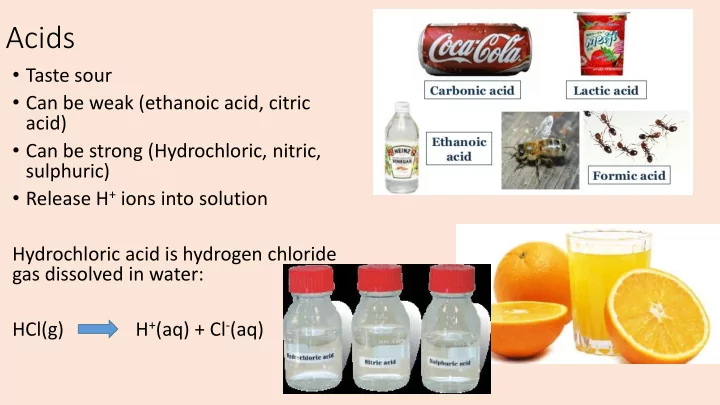

Acids • Taste sour • Can be weak (ethanoic acid, citric acid) • Can be strong (Hydrochloric, nitric, sulphuric) • Release H + ions into solution Hydrochloric acid is hydrogen chloride gas dissolved in water: HCl(g) H + (aq) + Cl - (aq)
Basically, its an alkali • Bases (including alkalis) neutralise acids, e.g. metal oxides, metal hydroxides • Insoluble in water • Soluble hydroxides are called alkalis • Form OH - ions when dissolved in water Sodium hydroxide is an alkali formed by dissolving solid sodium hydroxide in water NaOH(s) Na + (aq) + OH - (aq)
Ionic Equation for Neutralisation H + (aq) + OH - (aq) H 2 O(l)
The pH scale • Indicators are chemicals that change colour when added to acids or alkalis • E.g. litmus – red in acids, blue in alkalis • Universal indicator has a range of colours to show how acidic or alkaline a solution is.
Measuring pH • pH meter – digital display – automatic readings – more accurate – monitor over time (attached to data logger/computer)
Examples of lab acids and alkalis • pH meters must be calibrated before use, and rinsed in de-ionised water in between readings. Solution pH Colour with universal Indicator Acidic, alkaline or neutral? 0.1 mol/dm 3 hydrochloric acid 1 red strongly acidic 0.01 mol/dm 3 hydrochloric acid 2 red strongly acidic 0.001 mol/dm 3 hydrochloric acid 3 orange weakly acidic 0.1 mol/dm 3 nitric acid 1 red strongly acidic 0.1 mol/dm 3 sulfuric acid 0.7 red strongly acidic 0.1 mol/dm 3 ethanoic acid 3 orange weakly acidic 0.1 mol/dm 3 citric acid 4 yellow weakly acidic distilled water 7 green neutral 0.1 mol/dm 3 sodium chloride solution 7 green neutral 0.1 mol/dm 3 sodium hydroxide 13 purple strongly alkaline
Neutralisation curve
Weak acids Strong vs Weak • Ethanoic, citric, carbonic • React slower Strong acids • Can be concentrated or dilute • Hydrochloric, nitric, sulphuric • Higher pH (2-6) • React quickly • Only some molecules ionise • Can be concentrated or dilute (reversible reaction) – reaches • Low pH (0,1) equilibrium • Ionise completely - all H + ions go into solution CH 3 COOH ⇌ CH 3 COO – + H + HCl(aq) H + (aq) + Cl - (aq) • Lower concentration of H + ions • Higher concentration of H + ions
pH Values • Reducing the concentration of H+ ions by a factor of 10 increases pH by 1 Concentration of H + Concentration of H + pH Value ions (mol/dm 3 ) ions (mol/dm 3 ) 1 x 10 -1 0.10 1.0 1 x 10 -2 0.010 2.0 1 x 10 -3 0.0010 3.0 1 x 10 -4 0.00010 4.0
Salts • When acids are used in reactions, we replace the hydrogen with a metal particle. • The new compound is called a salt. • Salts form crystals of different colours and shapes
Naming Salts • Name comes from the • Hydrochloric acid = chloride metal and the acid • Sulphuric acid = sulphate • The metal replaces the • Nitric acid = nitrate hydrogen ions in the acid Sodium hydroxide + hydrochloric acid _________ + _______
Challenge – symbol equations • Hydrogen = H 2 • Hydrochloric acid = HCl • Sulphuric acid = H 2 SO 4 • Nitric acid = HNO 3
Recommend
More recommend